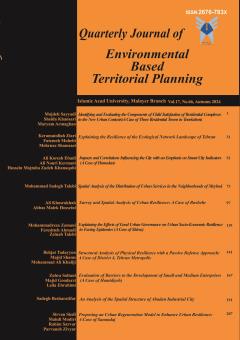Survey and spatial analysis of the resilience of urban areas (case study: Bushehr city)
Subject Areas :
Ali Khosrokhah
1
,
Abbas MalekHoseini
2
*
![]()
1 - PhD student in the field of geography and urban planning, Islamic Azad University, Malayer branch, Iran
2 - Associate Professor of Geography and Urban Planning, Malayer Branch, Islamic Azad University, Malayer, Iran
Keywords: spatial analysis, resilience, urban areas, Bushehr,
Abstract :
Spatial analysis is a methodological approach used to identify and examine the dispersions and interrelationships of phenomena, as well as their differences and similarities, within a geographical context. Resilience, as a form of foresight, reflects the dynamic nature of society’s responses to events and helps expand policy options to address uncertainty and change. This study aimed to investigate and spatially analyze resilience indicators in the urban areas of Bushehr. The research employed a descriptive-analytical method, with data collected through documentary sources and field surveys (questionnaire). Data analysis was conducted using the VIKOR multi-criteria decision-making process and Shannon entropy method. According to Shannon entropy results, the weights of the physical-infrastructural, institutional, economic, and social dimensions were 0.806, 0.512, 0.110, and 0.095, respectively. The findings, based on the VIKOR model, indicated that the overall physical-infrastructural, institutional, economic, and social resilience in Bushehr are in unfavorable conditions, with average index scores of 4.71, 3.84, 3.00, and 2.01, respectively.
1. پاکزاد، ج.، بزرگ، ح. 1391. الفبای روانشناسی محیط برای طراحان. تهران. انتشارات آرمانشهر.
2. حافظ نیا، م ر.، قادری حاجت، م. 1394. مفهومپردازی عدالت فضایی در جغرافیای سیاسی. فصلنامه بینالمللی ژئوپلیتیک،(40) 11 :60-32.
3. حسین زاده دلیر، ک.، موسوی، م س.، بایرام زاده، ن.، پاشاچینی،ه. 1400. بررسی تأثیر فضاهای شهری بر الگوهای رفتاری شهروندان (نمونه موردی: خیابان امام «ره»-ارومیه). جغرافیا و توسعه فضای شهری، 9(2)، (پیاپی 17) :۳۷ – ۵۳.
4. حیدری، ع.، احدنژاد روشتی، م. 1388. تحلیل سطوح دسترسی و مکانیابی مراکز خدمات بهداشتی با استفاده از GIS (مطالعه موردی: بیمارستانهای استان زنجان). همایش منطقهای ژئوماتیک اسلامشهر.
5. درستکار، ا.، ودایع خیری، ر. 1398. سنجش کیفیت زندگی بر مبنای رضایتمندی سکونتی (مورد مطالعه: محله گلشن تهران). علوم و تکنولوژی محیطزیست، 257-245.
6. رضایی، م ر. 1392. ارزیابی تابآوری اقتصادی و نهادی جوامع شهری در برابر سوانح طبیعی. فصلنامه مدیریت بحران، 3: 25-36.
7. رضایی، م ر.، سرایی، م ح.، بسطامی نیا، ا. 1395. فصلنامه دانش پیشگیری و مدیریت بحران، دوره ششم، شماره اول: بهار.
8. رفیعیان، م.، رضایی، م ر.، عسگری، ع.، پرهیزگار، ا.، شایان، س. 1390، تبیین مفهومی تابآوری و شاخص سازی آن در مدیریت سوانح اجتماع محور. CBDM برنامهریزی و آمایش فضا. 15(4): 41-19.
9. زنگنه معتمدی، م.، یاپنگ غراوی، م. 1399. ارزیابی الگوی علی تابآوری شهرها با رویکرد دیمتل فازی (موردمطالعه :شهرهای گرگان و شیروان). نشریه تحقیقات کاربردی علوم جغرافیایی، 20(56): 329-348.
10. شماعی، ع.، ساسان پور، ف.، حسینی، ر ع. 1398. تحلیل فضایی تابآوری شهری در محلههای بخش مرکزی شهر تبریز. پژوهشهای جغرافیایی برنامهریزی شهری، 7(2): 374-349.
11. فنی، ز.، معصومی، ل. 1395. سنجش و ارزیابی تأثیر سبک زندگی بر میزان تابآوری شهری(مطالعه تطبیقی محلات قیطریه و شکوفه شمالی). فصلنامه مطالعات جامعهشناختی، (19): 61-84.
12. کریمی، س.، مال میرزایی، ف.، موحدی، ر. 1395. تأثیر آموزش کارآفرینی و سودمندی آن بر قصد کارآفرینانهی دانشجویان کشاورزی دانشگاههای غرب کشور. پژوهش مدیریت آموزش کشاورزی، 8(38): 65-51
13. نوجوان، م ر. 1395. بررسی مورفومتری و پایش زمین لغزش به کمک سنجش از دور (مطالعه موردی زمین لغزشهاردنگ، غرب استان اصفهان). جغرافیای طبیعی، 9(3) (پیاپی 33): 95-107.
14. Adger, W. N. 2000. Social and ecological resilience: are they related?. Progress in humangeography, 24(3), 347-364.
15. Cote, M. , & Nightingale, A. J. 2011. Resilience thinking meets social theory: Situatin
16. Gaillard, J. C. 2010. Vulnerability, capacity and resilience: Perspectives for climateanddevelopment policy. Journal of International Development, (22), 218–232.
17. Keck, M. , & Sakdapolrak, P. 2013. What is social resilience? Lessons learned and waysforward. Erdkunde, (2), 5-19.
18. Klein, J. , Ettenson, R. & Morris, M. D. 1998. The animosity model of foreign product purchase: An empirical test in the peo china. Journal of Marketing, (62), 89 100.
19. Klein, S. B. , & Nichols, S. 2012. Memory and the sense of personal identity. Mind, (121),677-702.
20. Lucini, B. 2013. Social capital and sociological resilience in megacities context. International Journal of Disaster Resilience in the Built Environment, 4(1), 58-71.
21. Mazúr, E. , & Urbánek, J. 1983. Space in Geography. Geo-Journal, 7(2). 16.
22. Mihalopoulos, A. Philippopoulos. 2014. The Movement of Spatial Justice, Available Online at: https:// www. researchgate. net/ publication/ 275844357.
23. Norris, P. 2015. Theories of Political Activism. Developments in European Politics. Editors: Paul Heywood, Erik Jones, Martin Rhodes and Ulrich Sedelmeier (Palgrave Macmillan 2009). New York: Political Institute.
24. Soja, E. 2010. Seeking Spatial Justice. USA: University of Minnesota Press.
25. Wardekker, J. A. , de Jong, A. , Knoop, J. M. , & van der Sluijs, J. P. 2010. Operationalising a resilience approach to adapting an urban delta to uncertainclimate changes. Technological Forecasting and Social Change, 77(6), 987–998.

